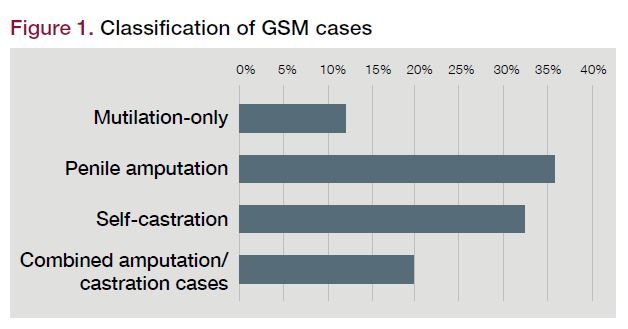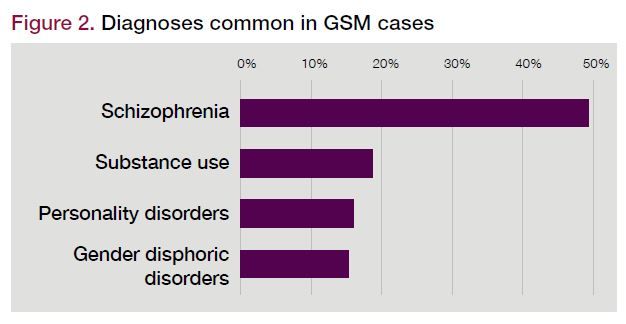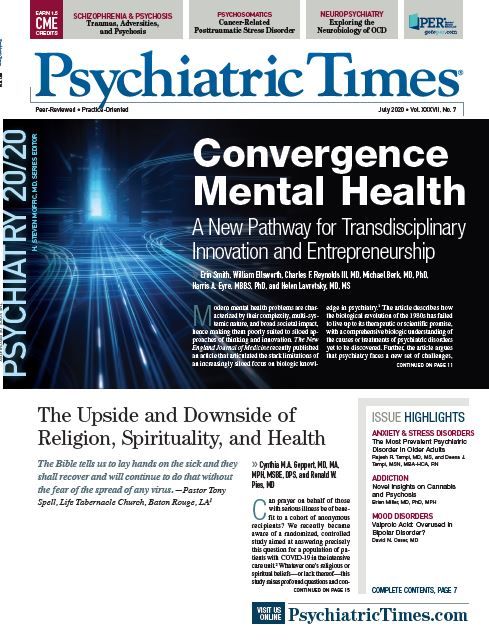Publication
Article
Psychiatric Times
Genital Self-Mutilation: A Cutting Conundrum
Author(s):
This form of nonsuicidal self-injury occurs within a spectrum of severity, and it is very likely that cases are both underreported and unpublished.
Srdjan/AdobeStock

CASE REPORT
Nonsuicidal self-injury to the genitalia, or genital self-mutilation (GSM), is an uncommon form of self-harming behavior seen primarily, but not exclusively, in male patients with psychosis or schizophrenia spectrum disorders. As with any nonsuicidal self-injurious behavior, the severity of GSM varies widely.1 Since GSM was first described in the medical literature in 1901, infrequent case reports have been published in both psychiatric and urologic literature. The majority of these cases have been examples of patients exhibiting a single episode of GSM often involving amputation of all or part of the penis and testicles.1,2

In this report, we present a complex and unusual case of repetitive GSM and explore the differential diagnoses and psychodynamic and psychosocial underpinnings, describing the patient’s unfolding presentation while exploring and expanding upon the limited existing literature on the subject.
Case presentation
A 26-year-old man presented to an outpatient mental health clinic with complaints of persistent depressed mood and emotional outbursts. During the interview, “Mr Carr” incidentally disclosed a 13-year history of repetitive, superficial cutting of the ventral aspect of his penis. Adding to the intrigue of this case, he initially denied any history of overt psychotic symptoms.
Mr Carr reported persistent depressed mood, anxiety, outbursts of anger, and increasing social isolation. He recently began taking courses to be trained as an information technology technician and soon after had a physical altercation with a classmate whom he believed was talking about him behind his back. This altercation led him to seek help at the clinic.
Mr Carr described a lifelong history of untreated depression with an aborted suicide attempt at the age of 12 (in which he held a knife to his wrist) and 1 hospitalization at the age of 24 due to suicidal ideation. As an inpatient, he was given an unknown medication, which he discontinued shortly after discharge. Around the time of this hospitalization, he began to feel self-conscious around his friends and family.
Mr Carr used to enjoy traveling and meeting new people but is now a loner without lasting friendships. He wanted to work as an information technology technician so that he could work in an isolated environment away from others. His interactions with family, classmates, and strangers on the internet have become more negative, which he attributes to his increasingly pessimistic world view. He endorsed low self-esteem and troublesome interpersonal sensitivity and felt that others are critical of him but admitted that he may be projecting his own feelings about himself onto those around him. He expressed a desire to improve his life and his social skills so that his interactions with others are more positive.
During the interview, Mr Carr was thoughtful, articulate, and had partial insight into his problems. He was attentive and polite to clinicians, and his thought processes were linear, logical, and goal directed. He was fully oriented with depressed affect. He scored 15 on the Patient Health Questionnaire-9 (PHQ-9), which indicated moderately severe depression. He denied current suicidal ideation.
When asked about nonsuicidal self-injury, he reported that since age 13, he has been cutting layers of skin from the ventral side of his penis about 2 to 3 times a year. He did not endorse erotic sensations or emotional relief as motivating these acts. Mr Carr stated all his sexual partners were female and that the cutting of his genitalia did not interfere with his sex life. He has not had any long-term romantic relationships.
Upon questioning, he denied any history of physical or sexual abuse. However, he later stated, “My whole life has felt like emotional abuse.” Mr Carr said his family makes him feel inadequate, and they wanted him to be circumcised. He said he was raised Catholic and was of Hispanic and Northern European ancestry. He did not know why he was not circumcised as an infant. An aunt recently asked him, “Why don’t you just have it done and be over with it?” He believes circumcision is not natural; he became visibly upset talking about the subject and declined to answer further questions regarding the cutting of his penis.
Mr Carr did not have a history of mania, auditory hallucinations, or visual hallucinations, and as far as he knows, there was no family history of psychiatric illness. He reported infrequent alcohol and cigarette use and daily marijuana use as self-treatment for his depression and anxiety. He used cocaine and psilocybin each on 1 occasion several years ago; he denied use of other drugs.
Mr Carr was agreeable to medication treatment and was started on 25-mg hydroxyzine and 30-mg duloxetine with instructions to increase the duloxetine dose to 60 mg after 7 days. He was also assigned to meet with a licensed clinical social worker for counseling.
Four days later, Mr Carr called a crisis hotline and reported that he was hearing voices. His psychiatrist was made aware of this call and phoned him to follow up. Mr Carr said he was unsure whether the voices were his neighbors “talking about him” or if the voices were internal. Two weeks later, he called his psychiatrist requesting a higher dose of hydroxyzine to treat his anxiety. When discussing what he was anxious about, he described an earlier event during which he was running errands when he became concerned that the strangers around him did not like him and were calling him names. He also stated that his hotel room was burglarized the night before, and he believed someone was “trying to intimidate [him].” Shortly after these incidents of increasing paranoia, Mr Carr accused his psychiatrist of not caring about him, moved out of state, and was lost to follow-up.
Psychiatric diagnoses and GSM
Although it is clear GSM behaviors occur within a spectrum of severity, a limitation of most literature reviews is that few have differentiated between low-intensity and more life-threatening GSM behaviors. The most recent systematic review of the available literature explored this issue directly but also called into question previous reports of the percentage of patients who are psychotic at the time of self-harm.1
Figure 1. Classification of GSM cases

Veeder and Leo1 sought to compare the psychiatric diagnoses behind 173 cases of GSM and to differentiate between mutilation-only and more extreme cases such as amputation of the penis, castration, or combined amputation and castration. Their review of the literature classified just 12.1% of GSM incidents as mutilation-only cases, whereas 35.8% involved penile amputation, 32.4% were cases of self-castration, and 19.7% were combined amputation/castration cases (Figure 1).
Psychiatric diagnoses were identified in 157 of the 173 cases examined (Figure 2). Common psychiatric disorders included schizophrenia spectrum as the most common (49%), followed by substance use (18.5%), personality (15.9%), and gender dysphoric (15.3%). These figures are in stark contrast to other reviews that placed the percentage of schizophrenia spectrum disorders higher, from 77% to 87%.3,4
Figure 2. Diagnoses common in GSM cases

Veeder and Leo’s analysis found that patients who had a diagnosis of schizophrenia spectrum disorders were more likely to amputate their penises (with or without accompanying castration) than patients with other diagnoses and that castration only was more likely in patients with gender dysphoria. In the cases of mutilation only, 23.8% of patients had a diagnosis of schizophrenia spectrum disorders, 19% had a diagnosis of substance use disorder, 19% had a diagnosis of personality disorder, 9.5% had a diagnosis of depression, 9.5% had a diagnosis of gender dysphoria, and for 14.3%, a diagnosis was unknown or not reported.1
Diagnostic considerations for Mr Carr
Because he was lost to follow-up, many questions regarding Mr Carr’s GSM cannot be answered, and so a wide diagnostic net must be cast to explore the underlying diagnoses that may explain his behavior.
Given Mr Carr’s unfolding psychotic symptoms with auditory hallucinations and persecutory delusions after his visit, and considering the previously mentioned data, it seems most likely that he was experiencing the onset of a schizophrenia spectrum disorder.1 If (conservatively) 49% of patients exhibiting any form of GSM and 23.8% with mutilation-only GSM end up with a diagnosis of a schizophrenia spectrum disorder, then the cutting of his penis may have been Mr Carr’s first presenting sign, preceding the major criteria for any schizophrenia spectrum disorder by many years. Moreover, Mr Carr described himself as a loner, consistent with personality characteristics often noted in patients before the onset of psychosis.
There is at least 1 case in the literature in which a man castrated himself years before the onset of overt psychosis. At the time of the autocastration, this man received a diagnosis of schizotypal personality disorder due to odd beliefs or magical thinking and social withdrawal. Three years later, the patient presented with overt paranoia, disorganized thought, and the diagnosis was schizophrenia.5
In addition to schizophreniform disorder, schizophrenia, and schizoaffective disorder, medication-induced psychotic disorder should also be included in the differential diagnosis because Mr Carr’s psychotic symptoms appeared days after the initiating duloxetine.6,7
In their review, Veeder and Leo1 found that mood disorders were not a common diagnosis in the setting of GSM: only 8.9% of cases of any form of GSM and 9.5% of mutilation-only GSM involved patients meeting criteria for major depressive disorder (MDD).1 Mr Carr reported a long history of depression and met MDD criteria at the time of his presentation to the clinic. Therefore, MDD with psychotic features should be included in the differential diagnosis.
There is also the possibility that Mr Carr has been suffering with bipolar disorder for many years. He described a time before his hospitalization in which he hitchhiked, traveled through many states, slept on the couches of strangers, and pursued sexual relationships with women he had only just met. Without more information, it is difficult to determine whether this was simply age-appropriate youthful adventurous behavior or hypomanic episodes. The fact that Mr Carr experienced psychosis after starting duloxetine further supports the inclusion of bipolar disorder with psychotic features in the differential diagnosis.
In light of his almost-daily marijuana use, substance use disorder should be considered. Substance use disorders were reported in 19% of individuals with mutilation-only GSM.1 Mr Carr denied any cognitive or other impairment from his marijuana use, but one cannot rule out that marijuana or other possible additives may have exacerbated his paranoia or triggered the auditory hallucinations. Dual diagnosis is not uncommon in patients with psychotic disorders. No urine drug screen was performed to confirm that marijuana was the only substance in his system. Mr Carr stated that he began cutting himself before he began using marijuana, suggesting that marijuana use did not explain his GSM.
When considering a personality disorder (diagnosed in 19% of mutilation-only cases) as an underlying diagnosis, Mr Carr did exhibit some cluster A personality traits such as suspicion of others as found in paranoid or schizotypal personality disorders and a preference for solitary activities as seen in schizoid personality disorder.1 He also had some symptoms of borderline personality disorder with self-mutilating behavior (although not suicidal) and described intense anger and paranoid ideation, which may have been stress related and evolved into psychosis. However, he did not meet DSM-5) criteria for any one disorder. Moreover, these personality traits merge with Mr Carr’s psychotic and mood symptoms.
Of the 4 diagnoses, Veeder and Leo found most commonly in mutilation-only cases, gender dysphoria is the least likely to explain Mr Carr’s case, as he did not describe any dissatisfaction with his gender.
It is very difficult to find examples of patients who have practiced GSM repetitively. A report from 2002 found only 13 cases of repetitive GSM in the literature. The authors reported that 8 of the 13 cases (61.5%) involved male patients with gender dysphoria and in only 5 of the cases (38.5%) was the patient psychotic at the time. Of these 13 total cases, 46.2% began with low-intensity, nonpermanent forms of mutilation and progressed to more severe acts.2 Although it is a small sample size, this report highlights the importance of asking these patients about gender dysphoria and determining whether their self-harming behavior has evolved in severity over time.
DSM-5 cites nonsuicidal self-injury as a condition warranting further research. While Mr Carr’s behavior does not entirely fit within the proposed criteria for this disorder, it is worth noting here. DSM-5 characterizes nonsuicidal self-injury as repetitive, shallow but painful injuries to the body surface that commonly produce feelings of relief. Many individuals who practice this behavior report feelings of tension and craving for the mutilation followed by reduced tension and anxiety after the act. Whether Mr Carr felt this pattern of craving followed by relief, we do not know, but it is clear he did not intend to kill himself by GSM.
Case reports on GSM are not only scarce, they are also inconsistent in their documentation of the psychosocial factors underlying these acts. In the case of Mr Carr, one wonders what role the pressure from his family to undergo circumcision played in his GSM or whether his feelings of having been emotionally abused contributed to self-punishing behavior.
Several psychodynamic theories have been proposed regarding GSM. Some have posited that it could be related to Freudian castration anxiety. Thompson and colleagues8 described 2 cases of GSM by 2 young men who had recently lost their fathers, suggesting that an unresolved oedipal complex may have contributed to the GSM. The authors proposed that guilt about an attachment to their mother, ambivalence toward the father, and intense grief might have led to self-punishment by carrying out castration fears.
Findings from another case study of 3 patients suggest that GSM could be related to castration anxiety and unresolved oedipal situations.9 A case study of 2 patients with schizophrenia who carried out a different and extreme form of self-mutilation, self-enucleation, suggested that castration fears and failure to resolve oedipal conflicts, severe guilt, and self-punishment all contributed to these desperate acts.10 Mr Carr did not share specific details about his relationship with his parents other than general feelings of emotional abuse to support unresolved oedipal issues as influencing him.
Other risk factors identified in the literature include feelings of guilt surrounding a sexual conflict, as well as experiences of separation, a recent failure, and a history of self-mutilation (genital and nongenital).2 Unfortunately, the case of Mr Carr, like cases before it, lacks many important details that could contribute to our understanding of this unusual behavior. Questions such as whether he felt guilty about a past sexual encounter or if he was punishing himself for disappointing his family may never be answered. Consistent with the diagnostic complexity of Mr Carr, for 14.3% of mutilation-only GSM cases, a diagnosis was unknown or not reported.1
Conclusions
GSM is an infrequent form of nonsuicidal self-injury that occurs within a spectrum of severity. It is very likely that less severe forms of GSM may be both underreported and unpublished. These factors combined with the immense shift in scientific understanding of human sexuality since the first cases were reported has contributed to the clinical mystery of GSM. When facing a case of GSM, clinicians should explore the motivations underlying the self-injury and consider a wide variety of psychiatric diagnoses. Medical treatment should be tailored to the patient’s presentation and underlying diagnosis, and the patient should be closely monitored for recurrence and escalation.
Ms Boyer is a medical student, University of Oklahoma Health Sciences Center, Oklahoma City, OK. Dr Tucker is Vice Chair of Education, Ungerman Endowed Chair of Psychiatry, Department of Psychiatry and Behavioral Sciences, University of Oklahoma Health Sciences Center. The authors report no conflicts of interest concerning the subject matter of this article.
References
1. Veeder TA, Leo RJ. Male genital self-mutilation: a systematic review of psychiatric disorders and psychosocial factors. Gen Hosp Psychiatry. 2017;44:43-50.
2. Catalano G, Catalano MC, Carroll KM. Repetitive male genital self-mutilation: a case report and discussion of possible risk factors. J Sex Marital Ther. 2002;28:27-37.
3. Greilsheimer H. Male genital self-mutilation. Arch Gen Psychiatry. 1979;36:441-446.
4. Nakaya M. On background factors of male genital self-mutilation. Psychopathol. 1996;29:242-248.
5. Myers WC, Nguyen M. Autocastration as a presenting sign of incipient schizophrenia. Psychiat Serv. 2001;52:685-686.
6. Preda A, Maclean RW, Mazure CM, Bowers MB. Antidepressant-associated mania and psychosis resulting in psychiatric admissions. J Clin Psychiatry. 2001;62:30-33.
7. Tomita T, Yasui-Furukori N, Kaneko S. Visual hallucinations during duloxetine treatment in a patient with major depressive disorder. Clin Neuropharmacol. 2013;36:170-172.
8. Thompson JN, Abraham TK. Male genital self mutilation after paternal death. Br Med J. 1983;287:727-728.
9. Money J, DePriest M. Three cases of genital self-surgery and their relationship to transsexualism. J Sex Res. 1976;12:283-294.
10. Maclean G, Robertson BM. Self-enucleation and psychosis: report of two cases and discussion. Arch Gen Psychiatry. 1976;33:242-249.❒






